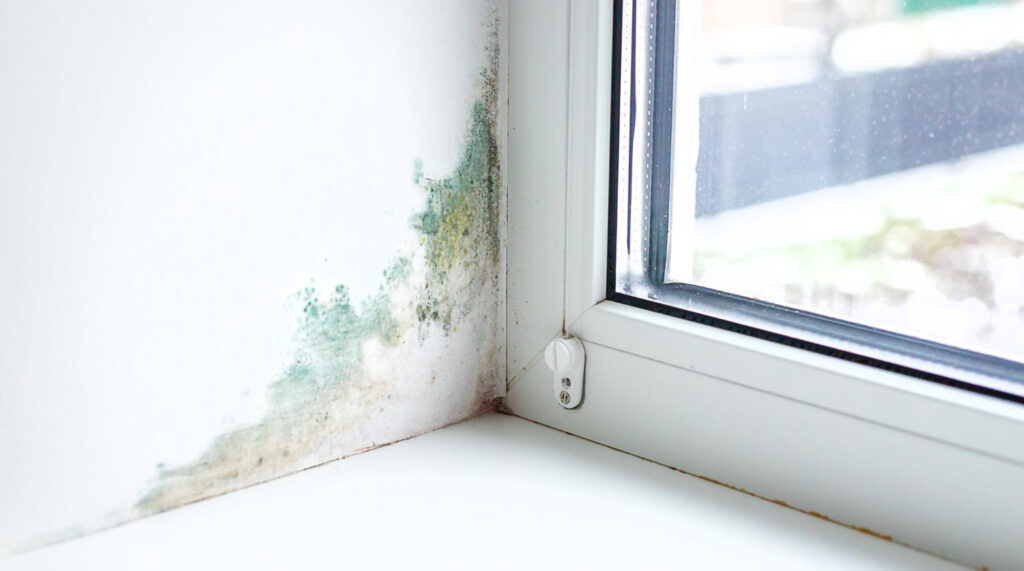As a homeowner, one of the most unsightly and frustrating problems you can deal with is damp patches on your ceiling. Apart from ruining the aesthetic appeal of a space, ceiling damp patches are usually indicative of more serious problems like water damage and structural issues.
Ceiling damp patches can also be a health hazard as they lead to mildew and mould growth which can create health issues for people with weakened immune systems and respiratory conditions.
There are a number of reasons why damp patches may form on your home’s ceiling, and in this article, we shall be taking a look at what those reasons are, how you can treat ceiling damp patches, and how to prevent future reoccurrence.
What Do Damp Patches on Your Ceiling Mean?
A damp patch on a ceiling typically refers to an area of discolouration appearing on the ceiling’s cold surface due to moisture infiltration. When this moisture gets into the material of your ceiling, it often causes discolouration or staining and the formation of mildew or mould. This can cause multiple issues, including affecting your health.
Plumbing issues, roof water leaks, and condensation build-up are usually the common causes of ceiling damp patches. The patches can range from small damp spots to covering a significantly large portion of the ceiling.
Signs of Ceiling Damp Patches
Some of the tell-tale signs to look out for include:
-
Watermarks, discolouration, and staining. These typically appear as brown, yellow, or greyish cold spots on the ceiling.
-
Dampness and musty odour due to mould and mildew.
-
Bubbling wallpaper and peeling paint.
Common Causes of Ceiling Damp Patches?
Ceiling damp patches have a number of potential causes. Some of the common ones are;
Rising Damp
This is when ground moisture rises through your building’s walls and into the ceiling. Rising damp usually occurs when a building is constructed on a damp site, has poor drainage, or has no functioning damp proof course. In addition to ceiling damp patches, rising damp can also cause damp patches on walls and flooring. You may need to consult with a professional damp proofer or damp specialists london to determine if rising damp is the underlying cause of the damp patches on your ceiling.
Roof Damage or Leaks
A damaged or leaky roof is another common reason why damp patches may form on your ceiling. When a roof is damaged, rainwater can easily seep in and create wet spots on the ceiling. If the damage to the roof is not promptly repaired, the patches will get worse and eventually lead to mould growth and structural damage (the ceiling may cave in).
Leaky Pipes (or Plumbing Issues)
Plumbing issues like broken or leaky pipes and clogs can also cause ceiling damp patches. If a broken pipe is the culprit, the patches will typically appear directly under the origin of the leak.
Condensation Build-up
Condensation can build up on your ceiling and lead to damp patches if there is no proper ventilation. This issue typically occurs in places like the kitchen or bathroom, where steam from cooking and showering accumulates in the air, cools down and forms damp patches on the ceiling over time.
Solutions to Ceiling Damp Patches
Addressing the Underlying Issue – When looking to treat ceiling damp patches, the first step you need to take is to determine where the underlying issue is coming from and promptly address it. You may need to fix a damaged roof, improve ventilation, repair a leaky pipe or hire a damp specialist to install a damp-proof course. It is only after you address the underlying cause of the problem that you will be able to prevent the patches from getting worse and damaging your property even further.
Remove the Patches and Replace Damaged Materials – Sometimes, you may need to remove and replace all the sections of your ceiling that have been affected by damp patches. The installation of new plaster or drywall may also be necessary. Do make sure that the area you’re planning to replace is completely dry before proceeding with the replacement.
Improve Ventilation – Poor ventilation is usually why condensation builds up. The excess moisture in the air condenses and forms damp patches on the ceiling. An easy way to combat this is to improve your home’s ventilation by opening up the windows (to improve airflow), installing exhaust fans (in the bathroom and kitchen), and making sure to minimise any activity (like drying wet clothes indoors) that can contribute to air moisture.
Invest in a Dehumidifier – A dehumidifier can help reduce excess moisture in the air and ultimately reduce damp patches on your ceiling. It also reduces humidity levels and prevents damp patches from forming on walls and ceilings. The absence of damp patches also means no mould or mildew growth.
Apply Water-Resistant Coating – Water-resistant coating is designed to repel moisture and prevent the seepage of water into a surface. Applying this type of coating on your ceiling can be a very good idea if it is prone to damp patches.
Preventing Ceiling Damp Patches
Some of the ways you can prevent damp patches from forming on your ceiling include; regular inspection and maintenance of your roof and plumbing, improving ventilation, maintaining proper insulation, keeping downspouts and gutters clean, and promptly addressing water damage.
Conclusion
Ceiling damp patches can be a costly and frustrating problem to deal with, which is why it is important to understand how to identify its signs, determine its potential causes and find ways of effectively treating it before the problem gets worse.

